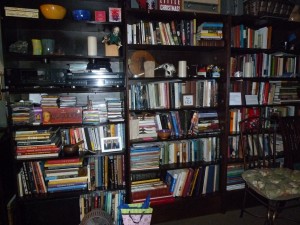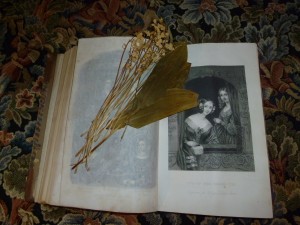I have been accumulating research books or, when they are very rare, consulting them since I first began to write historical novels. In the late 1980s when I began we still had many used book shops in New York City with wood shelves too high to reach but by ladder, shelves often sagging with the weight of books and with that definite smell of wood, dust, old paper, old bindings. Each new book was an enchanted encounter.
I have published five historical novels and have more in draft than I’m willing to admit. Each began with a history book: a rare volume on Elizabethan London printed about 1894 with a red binding which I found I don’t recall where, a biography with fragile pages of a 17th century English archbishop which was waiting for me in a very small shop for very little money. A small book with leather covers and gilt-edged pages by Marcus Aurelius discovered in a cold, empty New England book barn where there were tens of thousands of books and the footsteps of one lone browser…me. The original 1665 book on the early microscope by Robert Hooke (Micrographia) in the New York City Arents Collection and one of the thirteen extant copies of Shakespeare’s 1609 sonnets perused and almost wept over at Yale. (Was this WS’s own copy perhaps?) And the rather astonishing heavy Victorian Godey’s Lady Book printed in 1848 and given to me by a friend, between whose pages I found a sheath of very dry flowers and leaves, almost colorless. (Who pressed them there and tiptoed away?)
I bought more books by catalog in the 1990s: newer books but on rare subjects such as a history of English workhouses, the Glastonbury Tor. In my travels I bought books. On my trip home from England I brought twenty-seven books. That was before the planes weighed your luggage or perhaps the weight allowance was higher. (I think I gasped with delight when I found a map of Elizabethan London.)
Then came the fabulous internet and every book I ever dreamed of waiting in some shop in Arkansas or the Cotswolds for me. I ordered How Shakespeare Spent the Day. I ordered an old book on the daily lives of French artists. And now my husband has given me a Kindle and I have found to my extreme delight a number of books on 1860’s Florence published in that time and all for free. One has a list of banks and food shops of the period and where you can hire a donkey cart.
And when I finish a historical novel, what happens to the books? Well, I give some away sometimes. I truly recall giving several away which I had used for my Monet novel so do not understand why a huge pile of them still weigh down the top of a file cabinet in the den. My books on the Brownings are scattered all over the house but my English history books are mostly in one whole shelf. Sometimes I wander from room to room touching the book spines. I hear the books murmuring softly, “And when will you write me? There is a story waiting within my pages! What are you doing researching that other book in the next room…I know all about you, you see!”
And I tell them, “Perhaps 2012 will be a good year for your story!” I know they are patient books though they do grumble in their dusty way and that they know in their inky souls that I truly love them and that I will come back.
Historical novelist Stephanie Cowell is the author of Nicholas Cooke, The Physician of London, The Players: a novel of the young Shakespeare, Marrying Mozart and Claude & Camille: a novel of Monet. She is the recipient of the American Book Award. Her work has been translated into nine languages. Her website is http://www.stephaniecowell.com.


